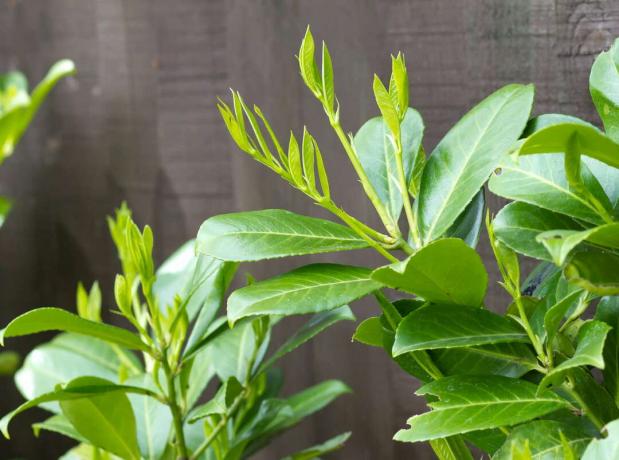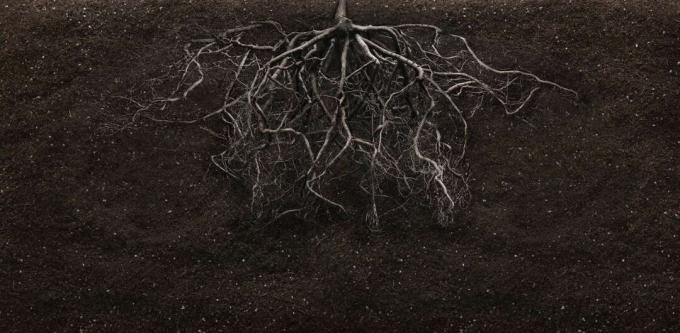The cherry laurel is one of the most popular evergreen ornamental and hedge trees. We will explain to you how you can most successfully propagate it yourself.

Of the Cherry laurel (Prunus laurocerasus) is very popular with us. It is valued for its evergreen, glossy leaves and the scent of its white flowers, which is its relationship to other woody plants of the genus Prunussuch as the ornamental cherry. As a bee pasture, it makes a valuable contribution to protecting insects. Further 10 bee-friendly plants see this article.
contents
- Propagate cherry laurel: Propagation of cuttings
- Propagate cherry laurel: sowing
- Propagate cherry laurel: cuttings through cracks
- Propagate cherry laurel: moss or roots in the water
Vigorous types of cherry laurel also protect you and your garden from prying eyes. But what you may not have known: The cherry laurel is extremely easy to propagate yourself. In the following you will find a list of the possible methods and instructions for the different types of propagation.
Propagate cherry laurel: Propagation of cuttings
This type of propagation is also used in tree nurseries, because it is simple, productive and, in contrast to propagation via seeds, allows guaranteed true-to-variety production. At the beginning there is the selection of the right mother plant. Of course, it should be healthy and adequately supplied with nutrients. The cuttings are cut in late summer. It is very important that the selected shoots are well matured, their tips must no longer be soft. This can only be achieved by avoiding high nitrogen levels in summer.
So between August and October you can check the firmness of the shoot tips and then cut them when they have become firm. The cutting is cut off at a slight angle with a sharp knife and should have a length of about 15 cm.
Now the larger leaves are shortened to reduce water evaporation and some may be removed so that a leafless, bare area is created that can be stuck into the earth.
The shoot is placed in a 3: 1 mixture of peat and sand (peat with lime raised to pH 6.5 - 7.5) or in special soil for cuttings that can be bought in specialist shops. It is important that the soil for cuttings is poor in nutrients, so do not use compost or even fertilizer. Our Plantura Organic herb & sowing soil is ideal for propagating cuttings. The pots used for propagation should have holes on the underside so that excess water can drain off and no waterlogging occurs.
Proceed as follows to propagate cuttings:
- Fill the pots with the dry earth to the brim. Now lift it several times up to 10 cm and let it fall from this height. Repeat the process five times. The substrate will collapse in this way and the cutting will later provide the necessary contact with the earth. If necessary, refill soil again and compact again until the filling level suits you.
- Now insert the prepared cutting at a slight angle and quite flat. If necessary, use a prick stick or a thin pencil to help drill a hole for the cutting to enter. A few inches of the bare stem should be stuck in the substrate.
- If you get the impression that the cutting is too loose and is almost falling out, then push it lightly into the soil. However, do not press it too hard, as otherwise insufficient oxygen will reach the interface and rooting will be inhibited.
- Now water the pots well. If you notice that soil is being washed away from the surface, you can sprinkle some more loosely on the soil.

Now the culture vessel should be placed in a warm place (above 20 ° C) with high humidity; cold frames or propagation boxes are suitable for this. If you have put the cuttings in pots, you can also use a transparent plastic bag and fix it to the edge of the pot with a tape, for example. However, you should ventilate it occasionally to avoid the colonization of fungi.
Make sure that the moisture is even - waterlogging should not form, nor should the substrate dry out. After about four weeks, the cuttings are rooted. At slightly lower temperatures it can take a little longer. Now separate the rooted cuttings in pots. In spring, the plants can be planted out as normal.
Propagate cherry laurel by cuttings:
- Select ripe, firm shoots of healthy plants in late summer.
- Cut 15 cm in length, shorten the leaves, remove some at the bottom.
- Prepare culture vessels with nutrient-poor soil for cuttings.
- Insert cuttings flat and at an angle and then water.
- Set up at over 20 ° C and with increased humidity; Avoid drought and waterlogging.
- It takes at least 4 weeks for the cuttings to be rooted. Then separate them in pots with normal potting soil and plant them out in spring.

Propagate cherry laurel: sowing
If you already have a cherry laurel plant, you may have noticed that small, new plants occasionally appear in their surroundings. This is because the cherry laurel multiplies independently by sowing it itself. In theory, you can dig up these little plants and plant them in a place where you want a new shrub. But one thing must be kept in mind: These little cherry laurel plants emerged from seeds. These seeds were produced through sexual fertilization in the flower of your plant. And now comes the crucial point: During sexual reproduction, the genes of the parent plants are first mixed in and then with each other. In addition, the cherry laurel is a cross-pollinator; it cannot “pollinate itself”, as some plants do (for example pea, potato, French bean) can. The small seedlings must therefore inevitably be hybrids from your plant and another that is not genetically identical to it. They can therefore never have exactly the same characteristics as the mother plant, so a true-to-variety propagation is not possible in this way.
Propagate cherry laurel by sowing:
- Seedlings are not identical to the mother plant
- Can be transplanted in spring or autumn

Propagate cherry laurel: cuttings through cracks
This type of propagation is not necessarily familiar to everyone, but it quickly delivers very robust and already somewhat larger young plants. The procedure is very straightforward: In spring, look for a healthy mother plant that will grow new shoots on its rootstock, close to the ground. It happens quite often. Pile up these shoots with an airy substrate mixture, for example fine crumbly soil mixed with some wood chips or peat substrate. This ensures the necessary ventilation and moisture for roots to form.
Repeat the piling up several times over the course of the summer as the young shoot grows. The bottom 20 cm should eventually be covered with the substrate. If the summer is very dry, moisten it moderately if necessary.
In autumn the shoots should have taken root in their substrate. Separate them as deep as possible from the mother plant with a sharp knife or rose scissors.

The rooted shoots are now felled in a sheltered place over the winter. This means that they are placed in a planting hollow with a loose substrate and possibly protected against frost with a cover. This procedure is necessary because they would probably not survive planting out yet. In the following spring, when severe frosts are no longer expected, you can plant out your new cherry laurel plants as usual.
Propagate cherry laurel by crackling:
- Selection of a healthy mother plant with stem-borne shoots in spring
- Piling up the shoots with an airy substrate; Repeat piling up as the shoot grows over the summer; possibly moisten
- Separate rooted shoots as deeply as possible from the mother plant in autumn
- Beat the shoots in a sheltered place over the winter
- Plant out in spring when severe frost is unlikely
Propagate cherry laurel: Moss or roots in the water
Cherry laurel can also be propagated by mossing or by rooting in the water. These two methods are less reliable than the first. For the sake of completeness, they are nevertheless briefly presented.

With the moss removal method, a healthy shoot is selected in spring. About 15 centimeters below the tip of the shoot, a 1 cm wide strip is peeled off down to the cambium. The wound is coated with a rooting hormone. Then it is surrounded at this point with a handful of moist soil for cuttings and wrapped in foil so that a kind of bag forms that is open at the top. This can be done with plastic wrap, which ensures that the soil stays moist. The bag is completely filled with soil for cuttings. If necessary, water can be used from above, otherwise the opening should be closed with a tape. The root formation must be controlled. If there are enough roots, the shoots can be separated from the mother plant and potted. To protect them from excessive water loss, they should be in a shady place with sufficient humidity (cold frame, plastic bag) for the first few days. They can be planted out next spring.
Propagate cherry laurel by mossing:
- Slightly injure a shoot in spring; Smear the injury with rooting hormone or “willow water”
- Surround the injury with a handful of damp moss or peat (pH 6.5 - 7.5), wrap with plastic wrap so that an opening remains at the top
- Water if necessary, check for roots after a few weeks
- Pot and keep shady and moist for the first few days
- Plant out in the coming spring

A cherry laurel cuttings can also be propagated in water, without any soil. For this purpose, a young shoot is selected in spring. The vessel used should be darkened. It is filled with water and, ideally, the cutting is fastened over the container so that it hangs freely in the water. With this method, too, it takes several weeks at around 20 ° C for roots to form. The cuttings are ready to be potted when the roots are a few inches long. They will be planted outdoors next spring.
Propagate cherry laurel in water:
- Cut young shoots of healthy plants in spring
- Place in darkened containers filled with water, set up at around 20 ° C
- When the roots are a few centimeters long, pot them in normal potting soil
- Plant out in the coming spring
Tip: For more reliable and faster root formation, previously prepared “willow water” can be used. It can be used as a replacement for rooting hormone as it also contains the hormones you need. To do this, young willow shoots are peeled, cut into pieces about two centimeters long and soaked in water for 24 hours. After removing the willow pieces, the "willow water" (also diluted) can be used for rooting.

Once your cherry laurel has developed roots, the next step is to plant it out. How it works and helpful tips on Cherry laurel plants can be found in our special article.



